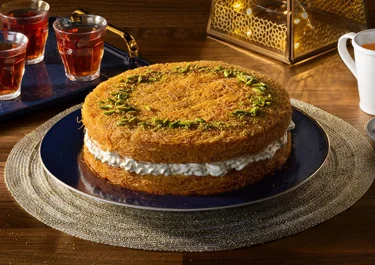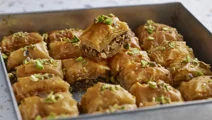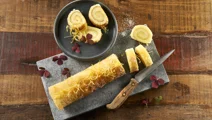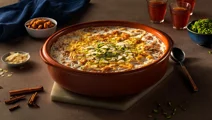Kunafa with cream

These single-serving Middle Eastern desserts are a perfect combination of crispy pastry, soft and silky cream, and a generous drizzle of orange blossom syrup. The dessert is known both as kunafa and knafeh depending on your place of origin. Both names refer to the same dish though. As such, both a knafeh and kunafa with cream will yield a textured and layered treat with a creamy filling and colourful toppings like pistachios, orange blossoms, and dried roses.
Ingredients
Kunafa pastry nests:
|
250 g
Salted butter
|
|
|---|---|
|
Cooking spray, for baking
|
|
|
450 g
Kataifi / kunafa dough, (frozen)
|
Syrup:
|
400 g
Sugar
|
|
|---|---|
|
2 tbsp
Orange blossom water
|
|
|
2 tbsp
Lemon juice
|
|
|
300 ml
Water
|
Cream Filling:
|
240 ml
Whipped cream
|
|
|---|---|
|
180 ml
Whipping cream
|
|
|
1 tbsp
Orange blossom water
|
|
|
4 tbsp
Sugar
|
For serving:
|
Pistachios, chopped
|
|
|---|---|
|
Oranges blossom, finely chopped
|
|
|
Dried rose petals
|
Instructions
Recommended information
Serving suggestion
Tips
It is important to detangle the kataifi pastry strands before mixing them with melted butter. Covering their surface with the fatty butter is how their crispness is ensured and if they stick together and do not get coated well, the nests may end up a bit doughy. Though the process of untangling them may be somewhat time-consuming, it is worth the effort. The easiest way to do so is to use your fingers. But if you thaw the frozen dough overnight in the fridge, it becomes much easier. Also, to keep it from drying out, expose it to as little air as possible by not opening the package until you are ready and putting the nests straight into the oven when you have prepared them.
Questions about kunafa
With an easy kunafa recipe like ours, it becomes simple to make kunafa with cream at home. To learn more about the popular Middle Eastern dish, read our answers to the most frequently asked questions about it below.
What is kunafa?
Kunafa, also called knafeh, is a traditional Middle Eastern dessert that according to some stories was created during Ramadan. The dessert is made by layering shredded kataifi dough drizzled with or soaked in flavoured sugar syrup with either a thick, cream filling or a sweetened cheese filling. The dish may be shaped in a variety of ways and the top layer of crust is often tinted with red or orange food die. It is typically garnished with ground or chopped pistachios. A cheese kunafa is usually served warm, whereas a kunafa with cream is served chilled or at room temperature.
How to make kataifi pastry for kunafa?
The crispy kataifi pastry used to make this dish is made from flour, cornflour, salt, vegetable oil, and water. Though many appreciate the ease of using store-bought frozen kunafa dough, it is possible to make it from scratch. However, following a kunafa dough recipe can be a bit time-consuming as the batter must be poured into a squeeze bottle and dispensed in a very thin stream onto a hot pan. Within 5-10 seconds, it will begin to peel off. You can then gently remove it with a spatula. The thin, lightly fried batter a kataifi pastry recipe yields may be further shredded to create the fine strands for which it is known.
How to make kunafa?
It is wonderful when desserts impress with their flavour as well as their look. Fortunately, this is one such dessert. To make it, start by getting the kunafa kataifi pastry ready so you can bake the nest-like crusts. As the nests cool, prepare the cream filling and sugar syrup so both have time to cool as well. Once the three main elements are chilled, assemble the desserts by sandwiching cream between two pastry nests drizzled with syrup. Garnish the desserts with pistachios, orange blossoms, and dried roses.
What is the difference between kunafa and knafeh?
There is no difference! Both kunafa and knafeh refer to the same dish and the difference is, as is the case with many other Middle Eastern dishes, purely dialectical. The sweet treat is known as dessert knafeh with cream throughout the Levant, while most people in Egypt as well as the Gulf States know it as kunafa. No matter what you call it though, its wonderful flavour makes a kunafa or knafeh recipe well worth trying.
What does kunafa taste like?
This dessert tastes sweet, creamy, nutty, and floral, all at the same time. It is, as such, quite a complex-tasting dessert. It has both crispy and creamy textures. The syrup-drizzled pastry crust and chopped pistachios are crunchy to bite into and beautifully complement the fresh and sweet cream filling. This filling, like the homemade simple syrup, has been flavoured with delicate orange blossom water for a delightful, floral touch.
How to reheat kunafa?
Unlike one featuring cheese, there is no need to reheat this kunafa with cream dessert as it is always served chilled or at room temperature. The deliciously whipped cream filling would begin to melt if it was piped onto warm kataifi pastry nests or if the assembled cakes were to be heated in the oven. As such, we do not recommend reheating these layered desserts.
Does kunafa need to be refrigerated?
Fresh kunafa with cream needs to be stored in the refrigerator. Since the filling is made with whipped cream, it is perishable and should not be left sitting a room temperature for long. It will keep for up to 3 days if stored in an airtight container. If you are making your dessert ahead of time, we recommend storing the shredded pastry nests and filling separately to protect the crispness of the former. The nests may also be stored in the fridge. After they have cooled, wrap them in cling film or aluminium foil. Store them for 1-2 days.
Classic crispy kunafa with cream
Sweet kunafa with cream drizzled with homemade simple syrup is a classic Middle Eastern dessert that is also perfect for iftar celebrations. In our rendition, these single-serve cakes are prepared with a creamy, thick, and soft cream filling. The contrast between this velvety filling and the crispy, golden brown nests it is nestled between makes for an interesting eating experience with a lot of texture and crunch.
Discover traditional shredded kataifi pastry
The long, thin noodle threads of pastry used in this dish are popular across the Middle East and Mediterranean. Due to its neutral taste and wonderful ability to become crunchy when baked, it may be used in sweet and savoury dishes alike. In this one, it is used to create a crispy crust fashioned to look almost like decorative birds' nests. By coating the so-called angel hair with melted butter and cooking mist, you can make this kunafa crust deliciously crisp.
You may have thought that this dessert's nests look a bit like vermicelli. Though they are made from different ingredients, their stringy texture is similar. If you enjoy these as well, we suggest you check out our scrumptious recipe for caramel vermicelli.
Layer with sweet cream filling and sprinkle with syrup
Sandwiched between two layers of crispy nests is the soft kunafa filling. This velvety filling is made with whipping cream and is as such wonderfully rich. Just like the homemade syrup, it has been flavoured with orange blossom water. This traditional orange blossom flavour serves to create a dessert with floral undertones that are noticeable without being overpowering. The aromatic blossoms, traditional symbols of good fortune, are also used to garnish the dessert for a decorative as well as brightening touch to lighten the cream-heavy treat.
Put a spin on a classic kunafa
There are many ways to experiment with this recipe. You can, for instance, try using walnuts, pecans, or almonds as a kunafa topping or give the filling a different flavour. Inspired by this recipe for yoghurt tiramisu with cream, you could introduce coffee into our kunafa recipe.
Taking inspiration from another delicious dessert like fruit salad with whipped cream and mini fruit tartlets, you might like to add fresh fruit or fruit preserves. Since both the filling and syrup contain orange blossom water, a great choice would be strawberry. Your fruit, berry, or fruit preserve of choice may be placed on top of the cream filling when you layer the desserts.









